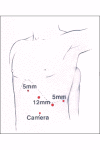Laparoscopic Splenectomy: Postero-Lateral Approach
- PMID: 31850246
- PMCID: PMC6910149
Laparoscopic Splenectomy: Postero-Lateral Approach
Abstract
In paediatric population, the laparoscopic splenectomy has been preferred to the open surgery during the last years. Due to the improvement of the technique and the devices, the indications to the laparoscopic splenectomy have been increased, even though there is still a variety of conditions in which the execution of this technique is arduous. During the preoperative consult there is the need to carefully evaluate the existence of cholecystic lithiasis, the haemoglobin level in patients with SCA, platelet count in children with ITP and the vaccination status. An anterior and a lateral or hanging spleen approach are primarily used for laparoscopic splenectomy. In the last four years, near the Section of Pediatric Surgery of the Department of Pediatrics, Obstetrics and Medicine of the Reproduction of Siena University, 8 cases of splenomegaly have been treated, 7 by lateral videolaparoscopic splenectomy (5 males and 2 females, with medium age of 10,5 years) and 1 by anterior approach (10 years). The advantages shown by these techniques allow the laparoscopic splenectomy to be considered as a valid alternative to the open surgery. In children's laparoscopic splenectomy, the rate of complications is considerably low and the the major problem is the intraoperative hemorrhage. With increasing surgical experience, the minimally invasive approach appears to be superior in terms of faster postoperative recovery, shorter hospital stay, perioperative and postoperative advantages. Therefore, the laparoscopic technique may soon be accepted as the standard method in patients requiring splenectomy.
Keywords: laparoscopic splenectomy; lateral approach; splenectomy in children.
Figures
References
-
- Rothemberg SS. Laparoscopic Splenectomy in children. Sem Laparoscopic Surgery. 1998;5(1):19–24. - PubMed
-
- Delaitre B, Maignien B. Splenectomy by the coelioscopy approach: Report of a case. Presse Med. 1991;20:2263. - PubMed
-
- Tulman S, Holcomb G, Karamanoukian H, et al. Laparoscopic splenectomy. J Pediatr Surg. 1993;28:689–692.888. - PubMed
-
- Rescorla FJ. Laparoscopic splenectomy. Semin Ped Surg. 2002;11(4):226–232. - PubMed
-
- Thompson WR, Parra-Davila E. Endoscopic Surgery in children. Vol. 36. Springer; 1998. Laparoscopic splenectomy; pp. 311–320.
LinkOut - more resources
Full Text Sources



